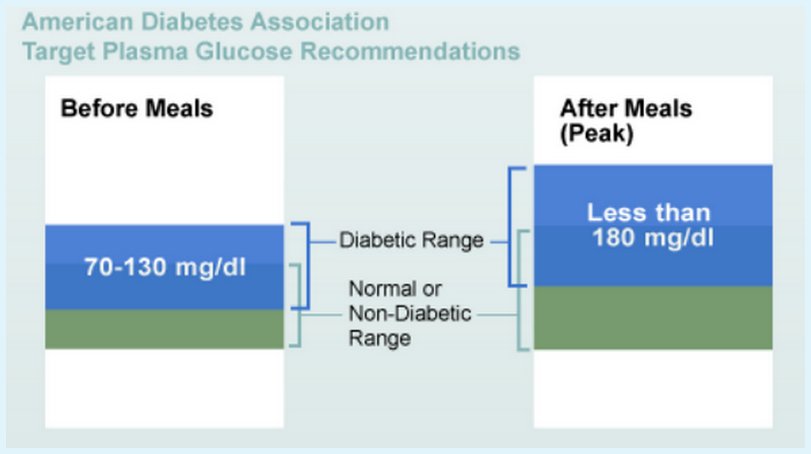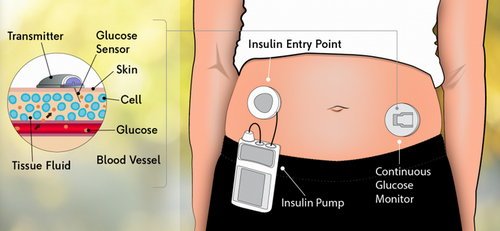Continuous glucose monitoring is a process of tracking down the glucose level round the clock at a regular interval. People with diabetes are put in a continuous glucose monitoring to proactively manage blood glucose level extremes such as sudden highs and lows.

Image 1: A continuous glucose monitor device attached on the arm.
Picture Source: cdn-images-1.medium.com

Picture 2: The blood glucose level chart (American Diabetes Association Recommendations for diabetics).
Photo Source: diabetesalert.net
What is the healthiest blood sugar level?
The healthy blood sugar level varies depending on the time of the day. If fasting for at least eight hours, the normal blood sugar level is less than 100 mg/dL. Two hours after eating, the normal blood sugar level is less than 140 mg/dL. (1, 2, 3)
What is a dangerously low blood sugar level?
If the blood glucose level is below 70 mg/dL, you are in a hypoglycemic state. Some people don’t have any symptoms that their blood sugar level is extremely low. Others notice changes in their body such as:
- Dizziness
- Hunger
- Weak
- Shaky feeling
A dangerously low blood sugar level is 54 mg/dL. It is important for the patient to receive the necessary treatment right away. (3, 4)
The purpose of continuous glucose monitoring includes the following:
- To monitor the rise and fall of blood glucose level.
- To find out the impact of a meal, exercise, and illness on a person’s blood glucose level.
- To come up with better diabetes management by simply minimizing the guess-work that comes with treating diabetes. (3, 4)
Who can benefit from continuous glucose monitoring?
- Patient with type 1 diabetes mellitus
- Patient with type 2 diabetes mellitus who are on basal insulin or multiple insulin injections.
- Those who are at risk for hypoglycaemia or unaware of hypoglycaemia.
- Those who are not meeting their A1C goal.
- Those who have a wide variable blood sugar level. (4, 5)
Components of a continuous glucose monitoring system
- Sensor – It sits underneath the skin and designed to measure the blood sugar level.
- Transmitter – It is attached to the sensor which sends the blood sugar level reading to the display device.
- Display device/monitor – A device that shows your sugar level. (4, 5)

Photo 3: A continuous glucose monitor measures the level of insulin in the interstitial fluid.
Image Source: www.ontrackdiabetes.com

Image 4: A continuous glucose monitor can be attached on different parts of the body such as the abdomen.
Picture Source: alpharettainternalmed.com
How does a continuous glucose monitor work?
A tiny sensor is inserted under the skin such as on the belly and arm. What the sensor does is it measures the interstitial glucose level; glucose located in the fluid between the cells. It tests glucose every few minutes as the transmitter sends information to the monitor.
Depending on the type of continuous glucose monitor, the monitor can be a part of the insulin pump or it can also be a separate device and you need to carry the monitor with you. Some continuous glucose monitor directly sends the information to your smartphone. (3, 4, 5)
How much is a continuous glucose monitor?
The cost of continuous glucose monitor varies depending on the model and brand. It ranges between $1000 and $1400. Aside from the monitor itself, you also need to buy a transmitter battery for the sensor to send a signal to the monitor.
The battery should be replaced at least once a year and a battery usually cost around $400 to $500.
Your insurance plan has something to do with the cost of the continuous glucose monitor. If the cost is too expensive for your budget, do not worry as some companies are willing to work with you. They can come up with a payment plan. (5, 6)
Is CGM covered by insurance?
Before, a continuous glucose monitor is covered by insurance. However, people who went on Medicare eventually lost their coverage. They have no choice but to pay for continuous glucose monitor out of their pocket. Fortunately, under Medicare Part B, durable medical equipment is covered. It will benefit people with type 1 and type 2 diabetes mellitus, especially those who take multiple daily insulin doses.
Two specific continuous glucose monitor brands are covered:
-
Dexcom’s G5 Mobile (Video : Learn Basics on CGM)
-
Abbott’s FreeStyle Libre ( video : How to insert Abbott’s FreeStyle Libre sensor and use the reader)
These brands are approved by the Food and Drug Administration for non-adjunctive use. According to Medicare, a therapeutic continuous glucose monitoring system like the ones mentioned above provide information necessary to make treatment decisions. Hence, they are covered as durable medical equipment. They met all the coverage criteria set by Medicare.
However, you have to keep in mind that Medicare coverage comes with conditions. This condition is for people using Dexcom G5 Mobile CGM. Medicare does not cover the said model if the patient uses the smartphone app even if they are using a separate receiver device for the reason that Medicare does not cover mobile devices. (5, 6, 7)
What is the best continuous glucose monitoring system?
A continuous glucose monitoring system comes in two forms: personal and diagnostic continuous glucose monitoring system.
- Personal continuous glucose monitoring system – It is the one used at home. You wear it for 24 hours a day and seven days a week. The sensory should be replaced every seven days. The data is then upload and share with the physician.
- Diagnostic continuous glucose monitoring system – it is usually found in the physician and endocrinology office. It detects blood glucose level every five minutes for a 24-hour period. It is worn for three days and the blood sugar level is checked three to four times a day usually before a meal. After three days, the sensor and transmitter are removed and the data are uploaded for a doctor’s interpretation.
To determine which continuous glucose monitoring system is the best, you should consider the following:
- Multisite – The best continuous glucose monitor is that one that you can use on different parts of the body such as the fingers and arm.
- Memory – Choose a continuous glucose monitor that has more memory; the one that can record hundreds of previous tests.
- Portable – Choose a highly portable glucose monitor. Fortunately, many continuous glucose monitors are tiny and can easily fit into a tiny pocket.
- Software inclusion – Choose a glucose monitor that comes with software. That way, you can easily download the data and share the readings with your doctor. If ever you lose the monitor, you can easily back up the data.
- Easy to use – Nobody would like to use a continuous glucose monitor with complicated features. In most cases, you are going to use the monitor under unideal conditions. So, might as well choose something that is easy to operate preferably something that with a larger readout.
- Smartphone integration – It is best to choose a glucose monitor with smartphone integration. The smartphone acts as the receiving device and so you can easily view your glucose reading.
- Longer sensor life – Ideally, you need to change the glucose monitor sensor every seven to 14 days. With the latest technological advancements, the life of sensors is increased significantly. Some glucose monitors have longer sensor life; can last for several months.
- Alert signal – Some brands of continuous glucose monitor come with alert signals wherein the wearer is given a signal of impending high and low glucose level. It is in the form of audible alerts or vibrating alerts. It is a vital feature because it enables the wearer to take action to keep the blood glucose at a safe level. (7, 8, 9, 10)
A continuous glucose monitor is a must-have device for people with diabetes. It is just a small device worn under the skin. It continuously measures the level of blood sugar throughout the day (24-hour period). It lets you monitor your blood sugar and alerts you if the level is too high or too low. To be specific, continuous glucose monitor measures the level of glucose in the fluid surrounding the body cells.
If you are going to compare the accuracy of reading using a continuous glucose monitor and a finger prick method, you will notice that there is a slight difference. There is a small time delay in the reading using a continuous glucose monitor. If you are planning to change your course of treatment, you need to undergo a finger-prick test.
A continuous glucose monitor helps track down your sugar level throughout the day and night. You will be able to detect if your blood sugar level is about to go high or drop enabling you to take the necessary action right away. Most importantly, you don’t have to undergo many finger pricks. It also helps in better blood sugar management.
On the other hand, the continuous glucose monitoring system might overload you with data, which is a bit confusing for other people. Some people are not comfortable wearing the device. In most cases, the need for finger pricked check is not completely eliminated. You still need to do some finger prick checks, especially for a more accurate blood sugar reading. (1, 4, 8, and 9)
References:
- https://www.dexcom.com/continuous-glucose-monitoring
- https://www.freestylelibre.us/
- https://www.medtronicdiabetes.com/treatments/continuous-glucose-monitoring
- https://diabetesstrong.com/fit-with-diabetes-part-4-the-pros-and-cons-of-cgm/
- https://www.niddk.nih.gov/health-information/diabetes/overview/managing-diabetes/continuous-glucose-monitoring
- https://freestylediabetes.co.uk/managing-and-monitoring/continuous-glucose-monitoring
- https://www.webmd.com/diabetes/guide/continuous-glucose-monitoring
- https://www.eversensediabetes.com/products/
- https://www.diabetes.org.uk/guide-to-diabetes/managing-your-diabetes/testing/continuous-glucose-monitoring-cgm
- https://www.diabetesselfmanagement.com/blog/is-continuous-glucose-monitoring-worth-it/


